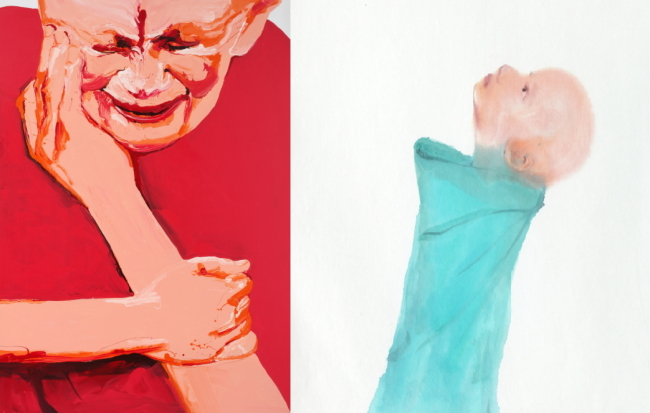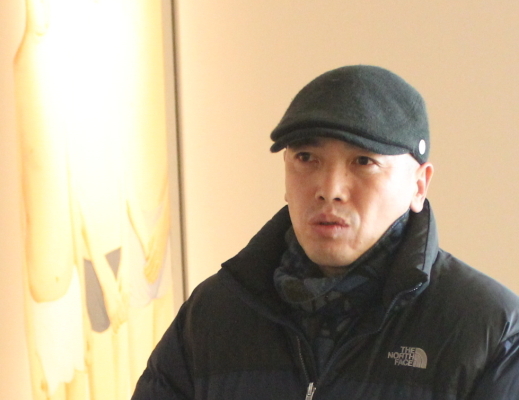Faces of modern China
Artist Li Fan’s portraits depict emotions of Chinese people shared with people around the world
By Lee Woo-youngPublished : Dec. 22, 2013 - 19:28

Portraits have been a popular medium for Chinese artists in expressing the political and social transitions experienced by modern China.
China’s top-selling contemporary artists Yue Minjun and Zeng Fanzhi have conveyed the underlying conflicts behind those political and social changes in portraits that reflect social tension.
But the strong expressions of social messages have gradually receded in paintings of emerging artists, who focus instead on emotions generally shared by an international audience.
One of them is the rising Chinese artist Li Fan, whose expressive style tells of the sufferings and anxieties of modern people he has observed not just in China, but in other parts of the world as well.
“For me, portraits are the means of expressing basic human emotions,” the 47-year-old artist said at the opening of his solo exhibition at Arario Gallery in Cheonan, South Chungcheong Province, last week. “The emotion is anguish. There are many emotions seen in a society, but this is what I observe the most in Chinese society,” he said.
“In China, the suffering is evident. It’s the society that is in conflict between the influx of new information and culture from the outside world and pride in the traditions we keep. But such sentiments exist in other countries, too,” he added.

Li doesn’t hire models for his portraits. The people in his works are anonymous figures in photos from news reports, or models in shopping catalogues and magazines, whose facial expressions Li finds suitable for his paintings.
Li’s solo exhibition is being held seven years since his first in Korea, at the Arario Gallery in Seoul in 2006. The exhibition features about 100 works completed since 2000 in Paris, New York, Beijing and Jejudo Island, offering insights into how the artist’s style and use of materials has changed over time. He now teaches printmaking at the Central Academy of Fine Arts, one of the most prestigious art schools in China.
On the first floor viewers are greeted by large-scale oil paintings. On the walls stand portraits of three young Chinese men smoking and wearing baggy hip-hop clothes, a woman in a dress and a man in a red shirt, with Li’s bold brush touches expressing the emotions on their faces.
The second floor portraits, in an ink-and-wash style, feature more subtle expressions.
“As a Chinese artist, I always wanted to use the traditional painting materials in my paintings, but not in too serious of a way like in Chinese traditional landscape paintings. These are my experiments using the traditional painting materials,” said Li.
Here, Li portrays a variety of people, from a child, a man and a woman to a traditional stage actor, through the use of light and refined brush strokes -- a technique that he has perfected over many years.
The ink-and-wash portraits show the emotions and individuality of the subjects through subtle degrees of intensity in the strokes and the empty spaces that create a sense of balance -- qualities also found in traditional Chinese ink-and-wash paintings.
“The use of the traditional painting materials will be handy if I get older and am no longer able to create large paintings,” Li joked.
The exhibition also features sketches, drawings and notes showing the artist’s contemplations on the psychology of modern people.
The exhibition “Homage to Life” runs until Feb. 23 at Arario Gallery Cheonan. For more information, call (041) 551-5100.
By Lee Woo-young (wylee@heraldcorp.com)




![[Music in drama] Rekindle a love that slipped through your fingers](http://res.heraldm.com/phpwas/restmb_idxmake.php?idx=644&simg=/content/image/2024/05/01/20240501050484_0.jpg&u=20240501151646)


![[New faces of Assembly] Architect behind ‘audacious initiative’ believes in denuclearized North Korea](http://res.heraldm.com/phpwas/restmb_idxmake.php?idx=644&simg=/content/image/2024/05/01/20240501050627_0.jpg&u=20240502093000)



![[KH Explains] Will alternative trading platform shake up Korean stock market?](http://res.heraldm.com/phpwas/restmb_idxmake.php?idx=644&simg=/content/image/2024/05/01/20240501050557_0.jpg&u=20240501161906)






![[Today’s K-pop] Stray Kids go gold in US with ‘Maniac’](http://res.heraldm.com/phpwas/restmb_idxmake.php?idx=642&simg=/content/image/2024/05/02/20240502050771_0.jpg&u=)